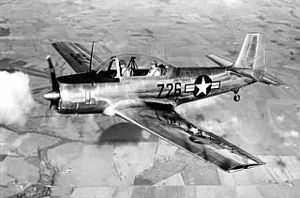Fairchild XNQ
| XNQ/T-31 |
|---|
 |
| Fairchild XNQ-1 tested as the T-31 |
| Role |
Primary trainer |
| Manufacturer |
Fairchild |
| First flight |
7 October 1946 |
| Number built |
2 |
|
|

Fairchild XNQ at Airventure 2009, Oshkosh, Wisconsin
The Fairchild XNQ (T-31) (Model M-92) was an American trainer designed as a standard primary trainer for the U.S. Air Force during the 1950s.
Design and development
Designed by Fairchild Aircraft as a replacement for current primary trainers, the XNQ-1 was the fastest primary trainer to date. The Model M-92 featured a controllable-pitch propeller, flaps, electronically operated retractable landing gear and all-metal skin with fabric-covered rudder, ailerons and elevators. Its unobstructed bubble canopy provided instructors and students seated in tandem with good visibility, and its cockpit instruments were arranged to match those found in contemporary jet fighters. To help students recognize controls, the landing gear handle was in the shape of a small landing gear wheel, and the flap handle was shaped like the airfoil of a flap.
Operational history
The XNQ-1 basic/advanced trainer was developed for the U.S. Navy and was first flown by Richard Henson on 7 October 1946. Two prototypes were flown as XNQ-1 (BuNo. 75725 & 75726). Delivered to the U.S. Navy in 1947 for trials, they were rejected due to problems with exhaust fumes leaking into the cockpit. The first prototype was subsequently to receive a number of engine changes, first powered with a 320 hp Lycoming R-680-13, then finally with a horizontally opposed 350 hp Lycoming GSO-580. The aircraft was destroyed in a crash in 1950.
The second aircraft (BuNo. 75726), with a larger stabilizer, was evaluated by the USAF in 1949 as a replacement for the AT-6, with the USAF selecting it on 24 March 1949 as a primary trainer. Designed to be acrobatic to teach pilots maneuvers, such as stalls, spins and rolls, Fairchild received a contract for 100 model 129s under the USAF designation T-31. However, the order was cancelled later in 1949, in favor of the Beech T-34 Mentor.
Fairchild dropped plans to develop the design as the company concentrated on other production contracts, including the C-119 Flying Boxcar.
Survivors
The second aircraft, privately owned, was still on the civil register on 15 January 2006[1] in airworthy condition.
Specifications
General characteristics
- Crew: two, pilot and instructor
- Length: 8.3 m (27 ft 3 in)
- Wingspan: 12.4 m (40 ft 8 in)
- Height: 2.7 m (8 ft 10 in)
- Empty weight: 1,338 kg (2,974 lb)
- Gross weight: 1,754 kg (3,898 lb)
- Powerplant: 1 × Lycoming R-680-13 radial, 238 kW (320 hp)
Performance
- Maximum speed: 282 km/h (175 mph)
- Range: 1,537 km (955 miles)
- Service ceiling: 4,880 m (16,000 ft)
See also
- Aircraft of comparable role, configuration and era
- Related lists
References
- Notes
- ↑ "Antique Attic". Atlantic Flyer, June 2006.
- Bibliography
- Green, William and Gerald Pollinger. The Aircraft of the World. London: Macdonald, 1955.
External links
|
|---|
| Manufacturer
designations | |
|---|
| | By role | | Experimental | |
|---|
| | Passenger transports | |
|---|
| | Military trainers | |
|---|
| | Military transports | |
|---|
|
|---|
| | Fairchild (Canada) | |
|---|
| | Fairchild-Dornier | |
|---|
| | Fairchild Hiller | |
|---|
| | Fairchild Republic | |
|---|
| | Fairchild Swearingen | |
|---|
| | American Helicopter | |
|---|
|
- See also
- Ranger/Fairchild aeroengines
|
|
|
|---|
| Advanced Trainer
(1925-1948) | |
|---|
| Basic Combat
(1936-1940) | |
|---|
| Basic Trainer
(1930-1948) | |
|---|
| Primary Trainer
(1924-1948) | |
|---|
| Main sequence
(1948-present) | | 1948 redesignations | |
|---|
| | New designations | |
|---|
|
|---|
| | Alternate sequences | | 1962 redesignations | |
|---|
| | 1990-1996 sequence | |
|---|
|
|---|
| 1 Not assigned |
|
|
|---|
| | General | |
|---|
| | Military | |
|---|
| | Accidents / incidents | |
|---|
| | Records | |
|---|
| | Misc. | |
|---|
|

